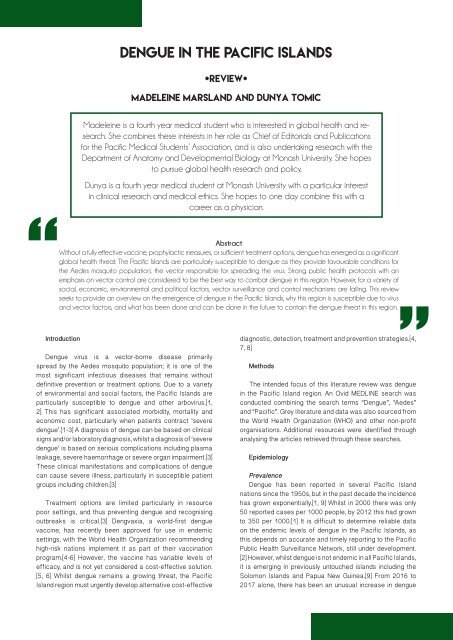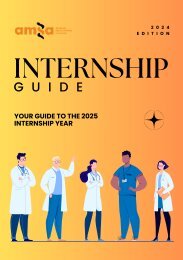Vector Volume 11 Issue 2 - 2017
You also want an ePaper? Increase the reach of your titles
YUMPU automatically turns print PDFs into web optimized ePapers that Google loves.
Dengue in the Pacific Islands<br />
[Review]<br />
Madeleine Marsland and Dunya Tomic<br />
Madeleine is a fourth year medical student who is interested in global health and research.<br />
She combines these interests in her role as Chief of Editorials and Publications<br />
for the Pacific Medical Students’ Association, and is also undertaking research with the<br />
Department of Anatomy and Developmental Biology at Monash University. She hopes<br />
to pursue global health research and policy.<br />
Dunya is a fourth year medical student at Monash University with a particular interest<br />
in clinical research and medical ethics. She hopes to one day combine this with a<br />
career as a physician.<br />
Abstract<br />
Without a fully effective vaccine, prophylactic measures, or sufficient treatment options, dengue has emerged as a significant<br />
global health threat. The Pacific Islands are particularly susceptible to dengue as they provide favourable conditions for<br />
the Aedes mosquito population, the vector responsible for spreading the virus. Strong public health protocols with an<br />
emphasis on vector control are considered to be the best way to combat dengue in this region. However, for a variety of<br />
social, economic, environmental and political factors, vector surveillance and control mechanisms are failing. This review<br />
seeks to provide an overview on the emergence of dengue in the Pacific Islands, why this region is susceptible due to virus<br />
“and vector factors, and what has been done and can be done in the future to contain the dengue threat in this region.<br />
Introduction<br />
Dengue virus is a vector-borne disease primarily<br />
spread by the Aedes mosquito population; it is one of the<br />
most significant infectious diseases that remains without<br />
definitive prevention or treatment options. Due to a variety<br />
of environmental and social factors, the Pacific Islands are<br />
particularly susceptible to dengue and other arbovirus.[1,<br />
2] This has significant associated morbidity, mortality and<br />
economic cost, particularly when patients contract ‘severe<br />
dengue’.[1-3] A diagnosis of dengue can be based on clinical<br />
signs and/or laboratory diagnosis, whilst a diagnosis of ‘severe<br />
dengue’ is based on serious complications including plasma<br />
leakage, severe haemorrhage or severe organ impairment.[3]<br />
These clinical manifestations and complications of dengue<br />
can cause severe illness, particularly in susceptible patient<br />
groups including children.[3]<br />
Treatment options are limited particularly in resource<br />
poor settings, and thus preventing dengue and recognising<br />
outbreaks is critical.[3] Dengvaxia, a world-first dengue<br />
vaccine, has recently been approved for use in endemic<br />
settings, with the World Health Organization recommending<br />
high-risk nations implement it as part of their vaccination<br />
program.[4-6] However, the vaccine has variable levels of<br />
efficacy, and is not yet considered a cost-effective solution.<br />
[5, 6] Whilst dengue remains a growing threat, the Pacific<br />
Island region must urgently develop alternative cost-effective<br />
diagnostic, detection, treatment and prevention strategies.[4,<br />
7, 8]<br />
Methods<br />
The intended focus of this literature review was dengue<br />
in the Pacific Island region. An Ovid MEDLINE search was<br />
conducted combining the search terms “Dengue”, “Aedes”<br />
and “Pacific”. Grey literature and data was also sourced from<br />
the World Health Organization (WHO) and other non-profit<br />
organisations. Additional resources were identified through<br />
analysing the articles retrieved through these searches.<br />
Epidemiology<br />
”<br />
Prevalence<br />
Dengue has been reported in several Pacific Island<br />
nations since the 1950s, but in the past decade the incidence<br />
has grown exponentially.[1, 9] Whilst in 2000 there was only<br />
50 reported cases per 1000 people, by 2012 this had grown<br />
to 350 per 1000.[1] It is difficult to determine reliable data<br />
on the endemic levels of dengue in the Pacific Islands, as<br />
this depends on accurate and timely reporting to the Pacific<br />
Public Health Surveillance Network, still under development.<br />
[2] However, whilst dengue is not endemic in all Pacific Islands,<br />
it is emerging in previously untouched islands including the<br />
Solomon Islands and Papua New Guinea.[9] From 2016 to<br />
<strong>2017</strong> alone, there has been an unusual increase in dengue<br />
38

















